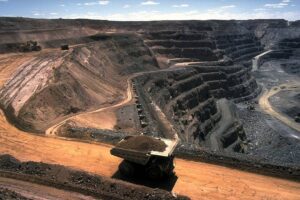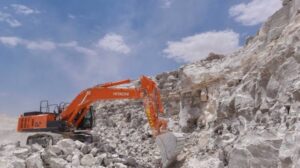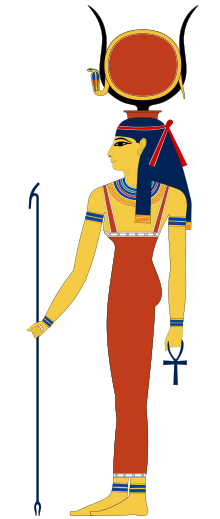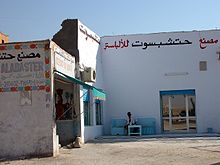Mining in Egypt

Mineral resources in Egypt There are many mineral resources in Egypt , some of them have been exploited and others are on the way to exploitation due to the investment conditions at the present time, and these resources vary in terms of type, quantity and places of distribution.
Iron in Egypt
Iron comes as one of the most important mineral resources that Egypt is famous for, as iron deposits are found in three main areas: East Aswan, Bahariya Oasis and the Eastern Desert . [1]

The Turin Papyrus illustrates the mining operations in the Hammamet Valley and is the oldest mining map in human history.
Iron deposits in eastern Aswan [
Iron deposits are found in more than 15 sites east of Aswan, associated with the Nubian sandstone formations that date back to the Cretaceous (Cretaceous) period.
Aswan iron ore is of Batroukhi sedimentary type, which mainly consists of hematite and goethite. The near-proven reserves of these deposits range from 120 to 150 million tons. Iron ore was exploited from the mid-fifties to the late sixties, when extraction of the ore stopped after the discovery of iron deposits in the Bahariya Oasis due to the high costs of transporting Aswan ore to the Iron and Steel Factory in Helwan.
Iron deposits in the Bahariya Oasis
Iron deposits are found in the Bahariya Oasis in four main areas: Al Jadida, Al Hara, Nasser and Jabal Gharabi. These deposits consist mainly of hydrated iron oxides known as limonite and goethite in addition to hematite and some other additional minerals. Iron deposits are currently being used to feed the Iron and Steel Factory in Helwan, where a railway line has been established linking the different ore sites in Bahariya Oasis and the plant in Helwan. The production amounts to about one million tons annually, and the proportion of iron ore ranges from 45% to 50%, which requires concentration operations to raise the proportion of iron in the ore. The reserve of ore is about 100 million tons.
Iron deposits in the Eastern Desert
These sediments are located in the central sector of the Eastern Desert, south of Al Qusayr near the Red Sea coast . They are sediments that were sedimentary in origin and then became metamorphic due to high temperature and intense pressure. The most important sites are Jabal Al Hadid, Wadi Karim, Al Dabbah, Umm Nar and Umm Ghamis, and the reserves are estimated at about 40 million tons.
The ore is found in the form of lenses or strips of magnetite, hematite and silica in the form of the mineral jasper, where the thickness ranges from several centimeters to about five meters. The economic benefit in different iron ores is a major goal, which is the production of cast iron, which can then be produced in different types of steel, especially since iron is one of the basic elements necessary in every field, whether at the civil or military level.
Manganese
Despite the multiplicity of locations of manganese ores, few of them are suitable for economic exploitation, and the Umm Bajma area in South Sinai Governorate is the most important of those areas where manganese ores are found in the form of lenses of average thickness of about two meters within the limestone dolomite rocks, which belong to the formations of the era Middle carbonate.
The ore consists mainly of the minerals pyrolizate, manganite and basilomelan. Manganese ore deposits are also found in the Abu Zenimah area in the Sinai Peninsula as well. However, the reserves in this area are relatively small and initially estimated at about 40,000 tons. As for the Halayeb region in the southeast of the eastern desert near the Red Sea coast, manganese deposits are available in the form of lenses and slit pockets, and the reserve is estimated at about 120 thousand tons.
Manganese is used mainly in steel and dry batteries, in the paint industry, and also in the chemical industry.
Titanium
The main ore for titanium is the mineral ilmenite, which consists of iron oxide and titanium . Ilmenite is found in several locations in Egypt, the most important of which are the Abu Ghalqa and Abu Dahr regions in the Eastern Desert.
Also, ilmenite is also found as one of the components of the black sand that was concentrated by the wind and waves in the northern delta between Rashid and El-Arish. Titanium is used in the manufacture of steel and paint alloys, and titanium and its alloys are the main nerve for aircraft manufacturing.
Tin and tungsten
Both tin ore, known as castearate , and tungsten ore, known as wolframite, are available in the regions of Nuweiba, al-Ajlah, Abu Dabab, Muwailha, and Zarka Ostrich, all in the Eastern Desert. Castrite is used as a primary source of the element tin that is used in the manufacture of tinplate and bronze alloys.
While wolframite is used in the production of tungsten, which is used in the manufacture of steel used in making high-speed machines and in the manufacture of electric lamps.
Due to its high hardness, tungsten carbide is used in the manufacture of drilling machines.
Copper
Despite the spread of copper ores in Egypt, it has not yet reached economic exploitation. The presence of copper ores, especially malachite, is concentrated in the Sinai Peninsula in the regions of Serabit El- Khadem, Feran and Samra.
There are also copper deposits associated with nickel ores in the areas of Abu Sweil, Wadi Haimur and Akram, all of which are in the Eastern Desert. It is worth mentioning that the ancient Egyptians mainly exploited copper ores for coloring.
Chrome
Chromium ore, known as chromite , iron oxide and chromium were discovered in the mid-forties in Egypt, and the ore is found in the form of strips, layers, or lenses in more than one area in the Eastern Desert.
Among the most important of these areas are: Al-Baramiya, Mount Dungash, Abu Zuhr, and Abu Marwa.
Chromite is used as the main source of the element chromium, which in turn is used in the manufacture of steel that is resistant to corrosion and rust. Chromite is also used in the manufacture of dyeing and leather tanning.
Phosphates
Phosphate is considered in Egypt to be one of the most important mineral deposits in both metallurgical and economic terms, because its production was and still occupies a prominent place in the field of mining. The reason for this is the widespread presence of phosphates in Egypt, as it is found in the form of a belt of phosphate deposits extending to a distance of about 750 km in length from the Red Sea coast in the east to the oases of Dakhla to the west.
As for its economic importance, it is summarized in the fact that it is exported abroad in large quantities, and part of it is manufactured in the form of chemical fertilizers classified as a type of superphosphate.
Phosphate sites of economic importance in Egypt are located in three main areas:
The Nile Valley between Edfu and Qena
One of the most important areas of existence is the Mahamid and Sebaa regions. The reserves of phosphate ore in the Mahamid area alone are estimated at about 200 million tons, and the proportion of phosphorus pentoxide reaches about 22%.
Geological studies have resulted in reserves estimated at about 1000 million tons in the areas adjacent to the Mahamid area.
The Red Sea coast between Safaga and Al Qusayr
Phosphate ore is located between Safaga and Al Qusayr port, in areas the most important of which are Jabal Dawi, Al Atshan and Hamraween, and reserves are estimated at 200 to 250 million tons of phosphate ore.
Western Sahara
The Abu Tartour Plateau , located between the Dakhla oases, represents the largest deposit of phosphate in Egypt, where the reserves of ore are estimated at about 1000 million tons, but there are some obstacles that prevent its optimal exploitation due to the presence of a significant percentage of impurities, which increases the cost of its production.
Talc
Talc deposits are found in more than 30 sites, most of them in the south of the Eastern Desert. The most important of these areas are Derheib, Al-Atshan and Umm Al-Satit. Talc is used in the manufacture of paper, soap, some medicinal drugs and industrial detergents. Talc is also located in Wadi Al-Alaqi, southeast of Aswan, and belongs to the Sahara Mining Company, Sami Saad.
Barite
Barite is present in Egypt with more than 10 sites scattered in the eastern and western deserts, and some of these sites are subject to economic exploitation. The most important of these sites are Jabal al-Hudi, east of Aswan, Hamatah, Wadi Dabb, Wadi Shaith, and Jabal al-‘Aba near the Sudanese border. Barite is used mainly in petroleum drilling fluids, in the preparation of barium compounds, and in the manufacture of paint, textiles, paper and some medicinal drugs.
Sulfur
Sulfur is found in Egypt mainly on the coast of the Red Sea and the Gulf of Suez, especially in the Jamsa, Ranga and Jabal al-Zayt regions . Sulfur is used in the manufacture of sulfuric acid, which in turn is used in a long list of chemical industries. It is also used in the manufacture of crackers, chemical fertilizers, pesticides, medical purposes, and textile bleaching.
Gypsum
Gypsum is present in Egypt in more than 25 locations, the most important of which are the Al-Balah area in the northern Ismailia governorate, the head of the stadium east of the Gulf of Suez in the Sinai, and Al-Alamein and Al- Ameed, west of Alexandria.
Gypsum is mainly used in the manufacture of sulfuric acid, building materials and plaster.
Quartz
Quartz is found in several locations in the eastern desert, the most important of which are Jabal al-Dib, Mount Marwat, and the Umm Heglig region. The proportion of silica is about 98%. Quartz is used mainly in optics. The ultra-pure quartz is used in the manufacture of solar cells by reducing quartz (silicon dioxide) to pure silicon, which is also used in the manufacture of semiconductors.
Kaolin
Kaolin deposits are found in three main sites:
A- In Wadi Natech, Sabaa Salama, and the gazelle beds, all of them in the Sinai Peninsula .
B – on the western coast of the Gulf of Suez at Abu Al-Daraj and Al-Jalalah Al-Bahariya.
C – In the Kalabsha and Aswan area.
Kaolin is one of the raw materials with large reserves of more than 200 million tons. Kaolin is used in the manufacture of ceramics, ceramics, rubber and paper.
Sodium and potassium salts
Sodium carbonate ( Natroun ) deposits are located in Wadi El Natroun in Beheira Governorate . As for the sodium chloride (rock salt) deposits, they are extracted from sea water by evaporation with industrial salines spread over the Mediterranean Sea in Marsa Matrouh and Idku. Alexandria, Rashid, Port Said and Lake Qarun in Fayoum. These deposits are the main source of both sodium and chlorine, which are included in a long list of chemical industries, the most important of which are caustic soda and hydrochloric acid.
Glass sand
It is found in abundance of high-quality white sand near the Abu Zenimah area in Sinai and in the Zafarana area on the Gulf of Suez, Wadi El-Natrun Al-Drah and Wadi Qena, and this type of sand is used in the glass industry.
Gemstones
Among the most important types of gemstones that are found in Egypt is turquoise, which is found in Jabal al-Maghara and Serabit al-Khadim in Sinai. Emerald is found in Ziara, Skeet, Umm Kabu, and Nijras in the Eastern Desert. As for Zabargad, it is found in Zabarhad island, south of the Red Sea.
These are the most important types of gem stones that Egypt was famous for since the Pharaonic civilization until now.
Feldspar
Feldspar is found in several locations, the most important of which are Aswan, Wadi Umm Disi and Aniji. Feldspar is mainly used in the manufacture of ceramics, porcelain, china, refractories and glass.
Ornamental stones
Ornamental stones are considered one of the most promising mineral resources that will be of great importance for two reasons, the first: their abundance and wide spread in the Egyptian lands, including most of the Red Sea mountain ranges, the southern part of the Sinai Peninsula and separate parts of the Western Desert, and the second: the great diversity in different types of rocks. Whether it is igneous, metamorphic or sedimentary rocks.
The following are the most important types of ornamental rocks in Egypt:
Granite
It is an underground igneous rock, and its most important quarries are found in Aswan and several places in the Eastern Desert and Sinai. However, Aswan granite is distinguished for its beautiful colors and historical fame, as the ancient Egyptians made statues, sarcophagi, obelisks, and offering tables.
Marble
The most important quarries are in Wadi El-Maa, Jabal Al-Rhamb, Wadi Dagbaj, Al-Allaqi and Abu Sweil.
Limestone
Egypt is characterized by a huge abundance of multi-colored limestone rocks, and among the most important quarries in Tora, Al Maasara, Bani Khaled, and Samalout in Minya, along the Assiut road. The oases of Dakhla and Kharga. There are also some quarries in Siwa and Alamein.
Breccia
It is a sedimentary rock consisting of pieces of different size and shape and is distinguished by its bright colors, especially the red breccia that is found in Al-Issawiya and Anba Bessada in Sohag governorate, and there is also a type of green breccia that is known archaeologically as Brescia Verde Antico.
Alabaster
It is a type of limestone, distinguished by its honey color, and it is of international fame and one of its most important quarries






Recent Comments